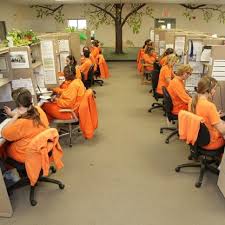“I never thought I’d be speaking to a CEO or COO,” Glennisha Dennis reveals. As a sales development representative for Televerde, a global sales and marketing technology company, she has far from the typical job available to someone serving an eight-year sentence.
Before her incarceration and employment with Televerde, Glennisha’s future was unclear. As she recounts, she was becoming more distant from her family and making poor decisions. When a drug buy between the father of her children and another individual evolved into a robbery, these choices led to her incarceration.
Today, Glennisha spends her workday connecting with her client’s potential customers and understanding their needs. Three years into her employment at Televerde, Glennisha is excited for her future and has a newfound sense of confidence: “It’s given me a second chance at life,” she says.
When Glennisha is released, she hopes to continue working for Televerde. She may be in luck: About one in four individuals who begin working at Televerde behind bars continue to work for the company on the outside.
Glennisha is just one of about 400 women employed by Televerde while behind bars in Arizona and Indiana. Like Glennisha, these women are able to gain expertise at a technology company and master the art of closing deals, strategizing with clients and corresponding with senior executives, all while serving their sentences. Their stories demonstrate the potential of public-private partnerships to help incarcerated people find employment and maintain it upon re-entering society.
Employment has long been touted as a solution to America’s re-entry problem. But in practice, it has been exceedingly difficult to ensure. One 2018 study by the Brookings Institution estimated that approximately half of the individuals exiting prison did not report any earnings in the third full calendar year following their release. In other words, three years after their release, many people who have served their debt to society are unable to support themselves financially.
Modern attempts to solve this unemployment crisis focus on encouraging post-release private employment. Under this model, prisons attempt to teach individuals skills through work opportunities available around the prison, leaving them to pitch their worth to employers on the outside. Some of these programs have shown marginal success. However, they still leave incarcerated individuals to navigate myriad barriers to employment, such as the stigma of a criminal record and supervision requirements, on their own.
Continuous employment models like Televerde’s would allow individuals to begin working with a private employer behind bars. These individuals would then have a reasonable chance to continue working for that employer — who already understands the challenges facing this population — upon their release.
Of course, in some cases, people may want to work elsewhere, and employers may not be able to permanently hire every individual. But if designed well, these programs can provide a world of new opportunities for those incarcerated. Whereas typical prison jobs can pay less than a dollar per hour, women employed by Televerde are paid a fair-market hourly wage, receive regular pay increases and earn overtime (with some deductions made for restitution, child support and the cost of incarceration, if applicable, and a personal savings account to be used upon release).
Given that Televerde makes a concerted effort to either continue employing people upon release or to place them with another employer, women like Glennisha have a better chance of becoming financially independent and embarking on a solid career path than their peers. In fact, according to Michelle Cirocco, Televerde’s chief social responsibility officer, the women of Televerde typically begin at positions with an average starting salary of $25,000 to $40,000 plus commission post-release.
Other benefits offered by continued employment to people behind bars are no less important. According to Sheila Jones, another Televerde employee, work responsibilities provide her with motivation to get out of bed in the morning: “I feel like I’m needed, and I can help people.” Other women echo similar sentiments. “If I didn’t have this job, I don’t know what would’ve happened to my brain,” shares Cristy Chacon, an 11-year veteran of Televerde. For these women, a meaningful job behind bars can provide purpose, elicit new interests and be a positive source of intellectual stimulation.
High-quality, steady employment for those exiting prisons may also translate into increased economic output and public safety for state and local communities. Women employed by Televerde boast less than a 7 percent return-to-prison rate. In contrast, women exiting Indiana prisons have about a 26 percent reincarceration rate. In Arizona, the return-to-prison rate is closer to 39 percent. Work opportunities behind bars with private employers could thus translate into millions of dollars of savings in public safety costs alone.
Less than three months away from her release date, Glennisha is eager to rejoin society. Thanks to Televerde, she has a definable skillset, an employment opportunity and a supportive community behind her. If additional private employers joined forces with state correctional agencies to create continuous employment programs, other individuals exiting prison would be able to say the same.

